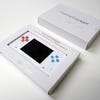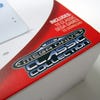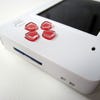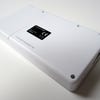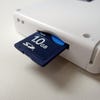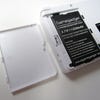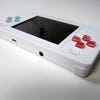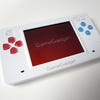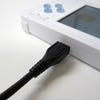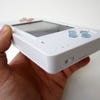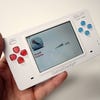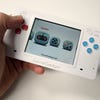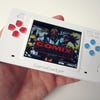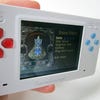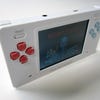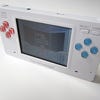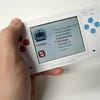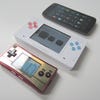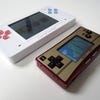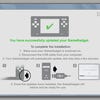GameGadget Review
Inspect a gadget.
When Blaze announced the GameGadget back in January, it confidently billed the system as "the iPod for Retro Gaming" and promised to create a handheld ecosystem that would not only allow games developers to monetise their forgotten classics from yesteryear, but also provide new and exciting software for the thousands upon thousands of players who would surely pick up this exciting new system.
That was five months ago, and the landscape is somewhat different now. First, the GameGadget's price was slashed from £99.99 to a more reasonable £59.99 - possibly what it should have been in the first place, some would argue. The initial launch was a bit of a shambles; units were sent out to customers in an almost unusable state, as Blaze hadn't finalised the online activation system which allowed the consoles to properly function. When that was eventually done, another issue arose regarding the GameGadget store, with users encountering problems purchasing new software.
Amid this chaos, Blaze quietly decided to offload responsibility for the GameGadget project to subsidiary Xploder - best known for its cheat discs - and that pretty much brings us to where things are in the present day. The online store is now live and functioning as it should, but the tidal wave of developer support mooted by Blaze all those months ago has yet to materialise. Of all the "major publishers" that Blaze's general manager Mark Garrett claimed were apparently in talks with at the start of the year, only Sega has pledged its allegiance at the time of writing, going as far as bundling ten of its Mega Drive games with the system free of charge.
It's safe to say that the project has been mired with difficulties and early adopters have been treated very badly, something Eurogamer will be covering in an upcoming news investigation, but with the dust now settling, is the GameGadget worth picking up?
The Hardware
The GameGadget is based on the Dingoo range of handhelds, which are incredibly popular in the Far East and have gained a solid global reputation thanks to their open source nature. At its heart is a MIPS-based Ingenic JZ4750 CPU clocked at 433Mhz, with 64MB of RAM and 2GB of internal storage - which can be boosted using media cards (a 1GB card is included). The console's screen is a 3.5-inch LCD panel with a resolution of 320x240 pixels.
Build quality is something of a mixed bag; the first time you pick up the GameGadget, chances are your reaction will be one of disdain. The cheap plastic casing hardly inspires confidence; it feels hollow and weightless, and the green power LED bleeds through the plastic to create a very off-putting aesthetic. However, closer inspection reveals that the GameGadget is actually a lot more robust than you might imagine, and you'll find no creaking parts or loose joints.
The d-pad apes the design made famous by Sony's PlayStation: although it looks like four separate buttons, it's actually a single piece of plastic. The four fascia buttons are springy and responsive, but the left and right shoulder triggers have far too much travel, and require a firm press before they register input.
The LCD screen is bright and colourful when viewed straight-on, but tilting the device even a small amount is enough to sully the image. Vertical viewing angles are dire, which means you'll need to maintain a steady posture during play, unless you want to experience strange visual fluctuations.
Two speakers can be found beneath the screen, and these continue the trend for low-rent parts. First impressions aren't good; when the GameGadget boots up, a short chord plays, which crackles ominously through the speakers. During gameplay, things are little better - if you push the volume right up, you'll notice marked distortion. Speaking of volume, there are no external controls for sound on the console at all. Altering the loudness of the speakers requires you to exit whatever game you're playing and drop back to the system settings menu.
"The GameGadget has a low-rent feel about it - with disappointing build quality and crackling speakers which distort at high volume. Screen quality is also noticeably sub-par."
The Software
Once you've become accustomed to the GameGadget's physical idiosyncrasies, you can begin to familiarise yourself with the equally unpredictable software. The first thing you're told to do when powering up a new system is to activate your console. This involves installing a piece of software on your computer which essentially acts as the console's version of Apple's iTunes. From here you can purchase DRM-equipped games and transfer them over to your GameGadget's internal memory using a MicroUSB lead (the system has no wireless capabilities whatsoever). One such lead is included in the box, but seeing as this is the de facto standard in the world of mobile phones, you're sure to already have several lying around your abode. The system's 1320mAh rechargeable battery is also topped up using this cable.
There's been a notable attempt to imbue the GameGadget with multimedia capabilities, but it's half-hearted at best. The photo viewer is limited by the system's low resolution screen, as is the video player. There's a text reader for eBooks - if you feel like digesting the latest bestseller on a 3.5-inch LCD screen - and finally the music player, which isn't actually too bad in terms of functionality. We can't say it would replace our standard portable music device though, and sound quality through a set of headphones is average at best.
Of course, this is a gaming system first and foremost. It's only when you first open up the GameGadget online game store that you realise the mountain the creators of this system have to climb. The Sega titles - which form part of the licensing deal agreed when the console launched a few months ago - constitute the vast majority of the current catalogue. The only other options are freeware titles ported from the aforementioned Dingoo handheld; you'll also find shareware versions of Doom, Hexen and Heretic, which prove to be surprisingly playable.
"GameGadget needed robust developer support from the outset - the depressingly bare online store is unlikely to make the system a hit, and attracting further publishers to the system will be an uphill struggle for Blaze."
To hit the ground running, the GameGadget really needed robust developer support from the outset - as it stands, the depressingly bare online store is unlikely to attract customers, and that means few developers will be convinced that the console is a viable commercial opportunity - a vicious circle if ever there was one. The Mega Drive games are a nice bonus, despite their familiarity - you get ten free just for activating your GameGadget unit, including Shadow Dancer, Shinobi III, Golden Axe and Ecco the Dolphin. A further 23 titles are available for download at prices ranging from £1.99 up to £3.99 for the more desirable titles - usually the ones starring Sonic, as a rule.
Although the GameGadget has Sega's blessing, it's interesting to note that the emulator used to run these Mega Drive titles appears to be derived from PicoDrive, a homebrew program which has been ported to a wide range of systems, including the Sony PlayStation Portable, GamePark GP2X and - naturally - the Dingoo. It's a stripped-down version - you have no access to options or settings - but the loading bar which precedes each game is identical. Performance is generally good, although it's disappointing to note that the emulation isn't anywhere near perfect.
Frameskip - a procedure which keeps the speed of emulation high by cutting out frames to reduce the load on the processor - appears to be in use, as games rarely move as smoothly as they do on the original Mega Drive hardware. More demanding titles - such as Comix Zone - feature larger amounts of slow-down and jerkiness, possibly due to their advanced nature when compared to earlier Mega Drive outings.
The fact that the GameGadget appears to ship with a freely-distributed emulator on board is somewhat disconcerting; you have to wonder if Sega was informed that this would be the case. It also means that Blaze and Xploder are effectively selling the work of homebrew coders in a commercially distributed product. It's hard to surmise exactly what the legal situation is here, or if Blaze has sought permission to include PicoDrive from the original developer, but the situation is a little concerning, to say the least.
"Perhaps one of the most disappointing aspects of the GameGadget is the weakness of the CPU - titles like Mega Drive Comix Zone feature slow-down and jerkiness which is very off-putting indeed."
Under-Powered, Under-Supported?
Dubious pre-installed software aside, another problem is the comparatively weak status of the hardware when compared to the latest advances being made in mobile computing. While the likes of the Samsung Galaxy S3 and Nexus 7 bring quad core power to the palm of your hand, the GameGadget's anemic CPU is stuck in a bygone era.
It has no 3D hardware acceleration whatsoever, so developers hoping to port over OpenGL-based titles are out of luck. Blaze itself admits on the developer section of the GameGadget site that the console is incapable of replicating the same standard of software seen on iOS and Android; instead, the system is geared towards 'simple' 2D gaming - hardly the kind of terminology that will have players reaching desperately for their wallets.
In what could possibly be seen as an effort to placate the slightly annoyed early adopters who were faced with issues purchasing games for the machine, Blaze has included a 'Sandbox' mode which allows the console to operate in much the same way as the Dingoo - you can download various emulators and install ROMs. Support exists for Neo Geo, SNES, Game Boy and Master System emulation, and the results vary wildly. The more primitive consoles can be replicated almost flawlessly, but SNES and Neo Geo are crippled by low frame-rates and skipping audio. This is probably not a fair indication of the GameGadget's power, as these emulators appear to have been ported over from the Dingoo with very little in the way of optimisation, but it's hardly an encouraging sign.
Blaze's decision to include the Sandbox mode is puzzling on many levels. The GameGadget is being positioned as a legal way for developers and companies to sell their software to the masses, so why give users the option to bypass the honest route and simply load ROMs onto the unit? How can Blaze possibly attract official support for the product when most of the audience will know full well that they can download the ROM from the internet for nothing? This choice could prove fatal in the long run; you only need look at the way in which piracy is impacting the fortunes of Android developers to see that having a completely 'open' platform is a risky business - even more so when you're struggling to attract developer support in the first place.
"Sandbox mode lets you import Neo Geo, SNES, Game Boy and Master System ROMs and results are highly variable. Games for the more powerful systems are crippled by slow, jerky emulation."
GameGadget: The Digital Foundry Verdict
The GameGadget is certainly a noble concept; a system which rekindles your love for classic games yet allows you to reward the original developers by legally purchasing the software. Given the incredible interest in the Dingoo system - which has sold over a million units worldwide - it's easy to see why the GameGadget exists; there's a market for retro retailing, and a definite niche to be filled.
The tragic thing is, we're not entirely sure the GameGadget is the system to do that. Despite some responsive controls, the build quality is generally poor and the LCD screen is plagued with terrible viewing angles. The audio side of things is just as disappointing, with the weak speakers and lack of physical volume controls making for a truly miserable user experience.
There's also the thorny question of developer support, which at the time of writing is virtually non-existent, apart from a smattering of Sega titles - most of which we've seen before on several different formats previously - and some hastily-ported homebrew games. When you consider that the GameGadget is facing the combined might of the iOS App Store and Android Google Play market, the gulf in both quality and quantity is staggering. Blaze and Xploder need to make good on their promise of developer and publisher interest, if only to prove that they haven't been leading consumers down the garden path for the past six months.
Still, one has to remember that the GameGadget retails for under £60 - a fraction of the price of your average smartphone and well below the cost of a Nintendo 3DS, Sony PlayStation Vita and Apple iPod Touch. That's dangerously close to impulse purchase territory, and if Blaze and Xploder can shift a few thousand units during the Christmas period, the increased install base will make the system more appealing to potential developers. Given the current state of the system and its lacklustre level of support, that's a pretty big if, however.






